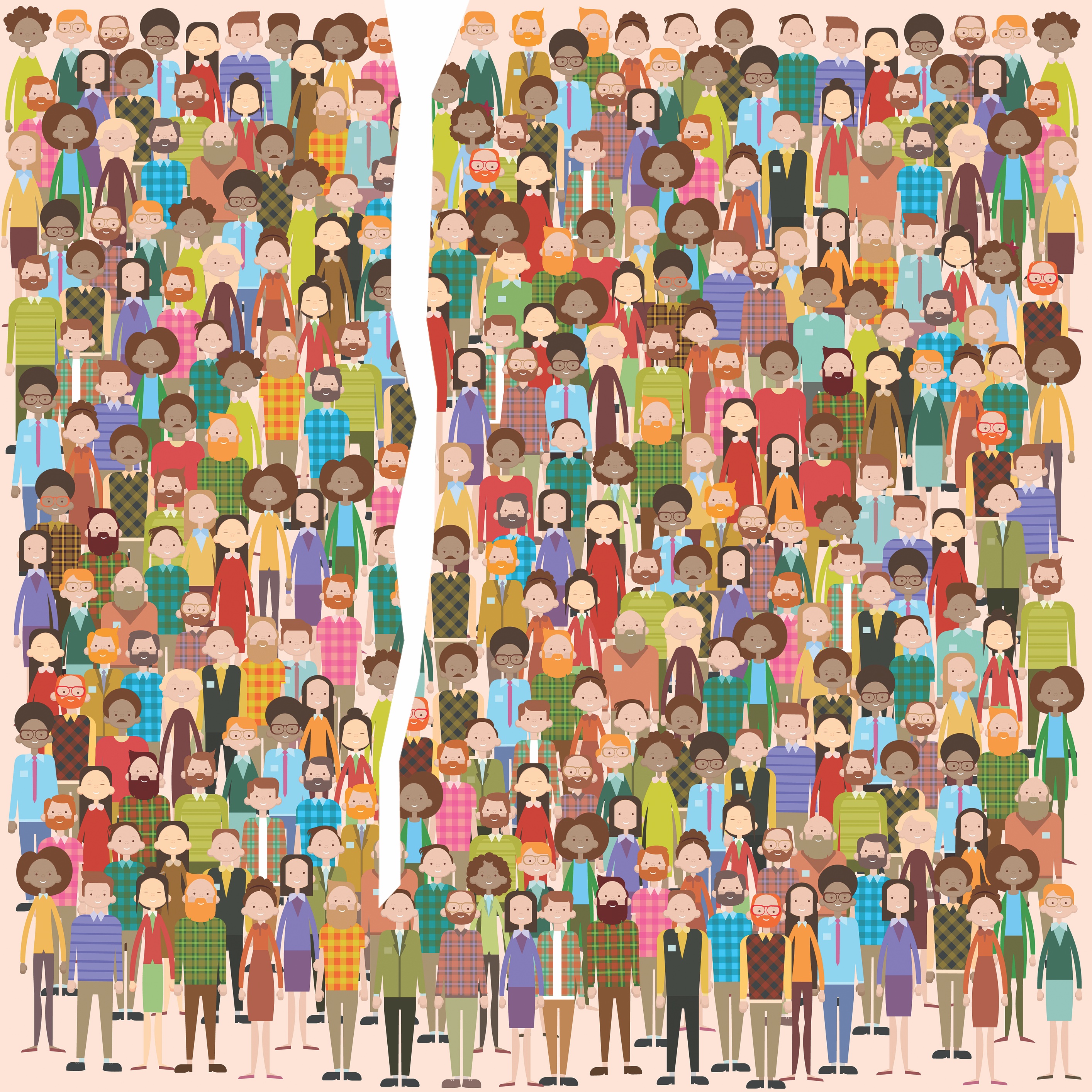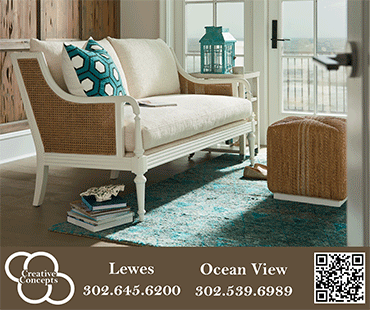
Coastal Delaware’s population has been skyrocketing for decades. Are we peas in a pod … or scorpions in a shoebox?
By Bill Newcott
From the October 2023 issue

Absolutely every time I hear someone complain about how crowded it’s getting in coastal Delaware, I think about a comic strip I clipped about 30 years ago.
In this particular entry from Patrick McDonnell’s “Mutts,” a dog and a cat are aghast at how many rabbits have recently been born in their neighborhood.
“Don’t you think something should be done about overpopulation?” the dog demands of one floppy-eared newcomer.
“Sure,” the bunny responds. “Now that I’m here.”
That call-and-response could echo just about anywhere you wander around the Delaware beach area: among drivers cruising for parking spots in Bethany Beach … patients crowding into a Lewes dentist’s office … diners waiting outside a Long Neck restaurant … bicyclists passing yet another forest being felled to accommodate a house-choked “preserve.”
The complaint rises like the rippling heat waves above the cars lined up on Route 24. It whines like the families who’ve just heard they won’t be getting into overcrowded Cape Henlopen State Park that day.
In 1969, the population of Sussex County was about 80,000 people (they were probably outnumbered by farm animals). By 2000, the number was roughly twice that — after which the population continued to grow between 2.5 and 3 percent annually until now, when about a quarter-million human beings call the county home. And it doesn’t take a census expert to know that most of that growth occurred on the eastern side of Sussex.
That’s a monumental demographic and economic shift — but there is, perhaps, a more profound element to all that growth: a stratification of coastal Delaware’s social structure based primarily on time of residency.
“You can’t really say you’re from around here,” a member of one longtime Lewes family once told me, “unless you can prove you were born either in Beebe hospital or on a nearby tabletop.”
Thousands of people alive today recall heading out of Rehoboth, crossing the bridge over the Lewes-and-Rehoboth Canal and seeing nothing but cornfields where today outlet malls and water parks glisten. Thousands more, arriving after the turn of the 21st century, remember driving the length of Fenwick’s Lighthouse Road while barely laying eyes on a single housing development. And hard as it may be to believe, recent newcomers will someday wax nostalgic about when there used to be an actual herd of cows flanking Dairy Farm Road near Lewes.
There are two ways to approach such overlapping tiers of memory. The good way is to weave those levels of experience into a unified local identity, one that embraces what coastal Delaware once was, what it is now, and what it can someday be. The bad way is to set up little chronological fiefdoms: bastions of resentment toward those who represent a time and place foreign to the one you treasure.
Chatting with area residents old and new, soliciting comments on the social media platforms Facebook and NextDoor, I found coastal Delawareans occupying both those extremes — and many points in between.
Driving along Beaver Dam Road near Lewes after dark, you may spot the illuminated peace sign on the barn owned by Joe and Lauryne Morris. They are a curious hybrid of the two aforementioned camps: A military kid, Joe spent his childhood summers on this stretch of land, which has been owned by his family for more than 200 years. But he didn’t live here full time until he and Lauryne retired 11 years ago.
“When I was a kid, we used to be able to play games out there right in the middle of Beaver Dam Road,” he says. “You could do that because it was so quiet, with all the cornfields, that you’d hear a car in the distance, and then it would be several minutes before you even saw it.”
Now, he says a bit sadly, it can take him several minutes to find a break in traffic so he can pull out of his own driveway.
“I know there are positives that come with development,” he says, “but sometimes I have a difficult time figuring out what they are. The more we add people, the more the things that we love disappear.”
That palpable melancholy is common among those who recall coastal Delaware as it was — and who see newcomers as determined to reshape it into something they don’t recognize. One recent NextDoor post from a writer in Georgetown, a 65-year resident, is, in its own way, heartbreaking (I’ve slightly edited the social media posts here for readability):
“Impatient neighbors … don’t like us running our 4-wheelers, dirt bikes, golf carts on our property, the roads, shooting in our backyards, bonfires, or having any redneck fun like we used too. ... Our lives are not what they used to be and now the locals have to be pushed around and told stupid trash talk, like, ‘If it wasn’t for us you’d still be rednecks walking around barefoot in chicken and pig dung.’”
The words catch me by surprise. As I read them, a wave of regret washes over me. I can’t help recalling a night, just two or three years ago, when I complained about a bunch of teenagers playing loud music and feeding scrap lumber into a huge bonfire behind an old barn on a field surrounded by communities, including my own. I told myself I was afraid someone would get hurt, but I now wonder if I might have just been growling, in effect, “Get off my lawn!”
Later, I learned those were the farmer’s kids and their friends. They were having one last celebration on the family’s land — which was about to be plowed under to make way for yet another housing development.
Maybe the man from Georgetown is right. Maybe I’m just a troublemaker from the city.
Writers love to break people and things down into groups, and it seems to me that, when it comes to the continuing influx of newcomers, the sentiments of long-term residents of coastal Delaware can be isolated into two categories:
How Awful: These strangers are ruining everything.
How Wonderful: An infusion of new people from different places and backgrounds can only enrich our local culture.
It’s not hard to find those who fall into the first camp: Social media is gurgling with resentment for newcomers who, as several writers observe, “bring their problems” with them. No one states explicitly what those problems are, but they seem to imply that crime and a haughty attitude — pointedly observed by the gentleman from Georgetown — are two of the most damning imports.
“You came here from there because you didn’t like there,” writes another man in Georgetown, who may have missed his calling as a beat poet. “Now you want to change here to be like there. … If you want here to be like there you should have never left there to come here!”
It must be noted that there is considerable — and equally virulent — backlash to this position from recent arrivals.
“We bring with us our 401(k)s,” writes a NextDoor poster from Bay Colony. “So we create more jobs, pay your crazy prices for lawn cutting, handyman services, repairs, etc. We improved your medical facilities by creating a need for more hospitals and good doctors. … Sounds to me like we enhanced your local communities with our presence!!!”
Group B, the somewhat happier group of long-timers, has a more nuanced view toward the influx of humanity. They don’t deny the effects of the continuing crush — but they consider the infusion of new blood essential to the development of the coastal community.
“If we didn’t have all these people arriving here, we wouldn’t have so many wonderful restaurants to feed them all,” says Helen Morris, who moved here from Dover with her husband 15 years ago.
We are sitting in one of those restaurants right now, its tables jammed with diners representing, at a glance, a variety of ages, vocations and ethnicities.
“We would not have the Cinema Art Theater. I doubt Clear Space Theatre would be open year-round if not for the permanent residents who’ve moved in.”
Besides, she says, rather than seeing the Delaware beach area purely as a place to escape urban hubbub, there are those who actually consider moving here a step up culturally.
“Look at my husband and me,” she says with a hint of exasperation. “In Dover, there were no bookstores!”
She leans across the table.
“They didn’t even know what a bagel was!”
It’s time for Morris to head back to her home in Five Points. Gathering her things, she glances out the restaurant window. Traffic on Route 1 is at an absolute standstill.
“Hmm,” she muses. “I may want to rethink my position …”
Continuing my commitment to pigeonholing entire groups of people, I’ve concluded that, like the long-termers, newcomers to coastal Delaware can be isolated into two distinct parties:
Everyone makes me feel so welcome.
I feel somehow unclean.
We’ll tackle the second group first, because, frankly, I want to end this article on a positive note.
“I never tell anyone I’m new here,” confesses a woman who lives near me, and who asked that I not reveal her name. “There’s too much negativity toward people who’ve just moved into the area. Have you seen the things they say about us on Facebook?”
She has a point. As we’ve seen, social media almost never fails to bring out the worst in people, and that seems doubly true on the matter of coastal Delaware newcomers. That brand of clannish identity can even have professional repercussions, according to one Facebook responder.
“We moved here 12 years ago,” she writes. “We were excited to tell the story of where we came from, but it singled us out and limited my employment opportunities.”
A decade of experience, she says, has taught her that “We are much more accepted by the locals if that heated subject doesn’t come up in conversation.”
“Some people are ‘From-Heres’ and others are ‘Come-Heres,’” observes one NextDoor commenter who, like that Georgetown fellow, seems to find lyrical inspiration when explaining the coastal cultural divide.
“I’m a Come-Here, and the From-Heres are convinced we’re running their way of life to extinction.
“Come-Heres can never become From-Heres. It’s a cultural thing. But we have to be kind.”
If the Come-Heres and the From-Heres enjoy any kind of common ground, it is frustration with the condition of coastal Delaware’s road infrastructure. Whether they’re pro-growth, anti-growth, or somewhere in between, there’s barely a soul I communicated with who did not pretty soon bring up the indisputable fact that while the government is remarkably efficient at approving new communities, and builders seem capable of hurling up houses that sprout in former fields like morning mushrooms, road-widening projects proceed with all the stately pomp of Mendenhall Glacier.
“I turned 74 this past weekend,” says Joe Morris. “I really thought Five Points would be fixed before I got this old. But it’s not fixed yet.”
Still, one Facebook responder tells me, “I’ll see the same people here complain that the infrastructure is falling behind — and also complain about the traffic created by the work being done to improve it.”
She ends with a “shrug” emoji.
Lizz Kula has little patience with those who rend their robes over the traffic in coastal Delaware. She moved here just a couple of months ago. From Philadelphia.
“I mean, really?” she says, her eyes wide with botheration. “I want to ask them, ‘Have you never driven in a city?’ I’ve waited an hour for a subway to take me two miles, so, yeah, I’ll deal with some traffic on Route 1.
“I feel like people should be required to live in a city for five years before they come here and start complaining.”
We are sitting at a window in Kula’s new home, overlooking the broad, finely trimmed public green at Paynter’s Mill near Milton. Her dog, Pancake, a squat pit bull, is resting his head — as big as a toaster — on my lap.
Kula was aware of the online negativity that emanates around the subject of area newcomers, but she dismissed it out of hand. For good reason. She’s an executive assistant at Microsoft and understands well the dynamics of online discourse: When anonymity is available, confrontation is likely to escalate.
She doesn’t even see it as a bad thing.
“People will always complain,” she says. “I think complaining actually makes people feel closer to each other.
“The trouble is, the Internet has made the world so much smaller. Like, there was this tiny little pocket, this lovely little coastal town that was a secret for so long. But there are no secrets now. Lewes was never going to stay a secret. So just take care of the place the best you can.”
I am especially glad to meet up with Kula because I know from the moment she begins to speak that she’s going to provide my happy ending. Here it is:
“Look, I’m coming off 12 years in Philadelphia,” she says, slipping a treat into Pancake’s gaping maw. “I was at a gas station recently on Savannah Road in Lewes. It was after hours, and someone was having trouble with the pump. A guy approached them and I was like, ‘Oh, no!’ But he just wanted to help. In Philly, that would have been a very different scenario.
“I go to the grocery store here and people just smile at me. Everyone is always asking if they can help with something. Yeah, I know people complain that they can’t get a doctor’s appointment around here, but have you tried to get an appointment in the city?”
On the green below, a young man and his dog are playing Frisbee. Pancake seems interested.
“Let’s just enjoy the fact that mostly everyone here is nice and friendly and helpful,” says Kula. “It’s a little piece of paradise. I’m very happy to have stumbled upon this. It’s perfect.”
I don’t care if you’re a From-Here or a Come-Here. That’s a happy ending. n
Bill Newcott, an award-winning film critic who was named Writer of the Year in 2020, 2021 and 2022 by the International Regional Magazine Association, has been working on becoming a local since he moved to the Lewes area in 2013.



